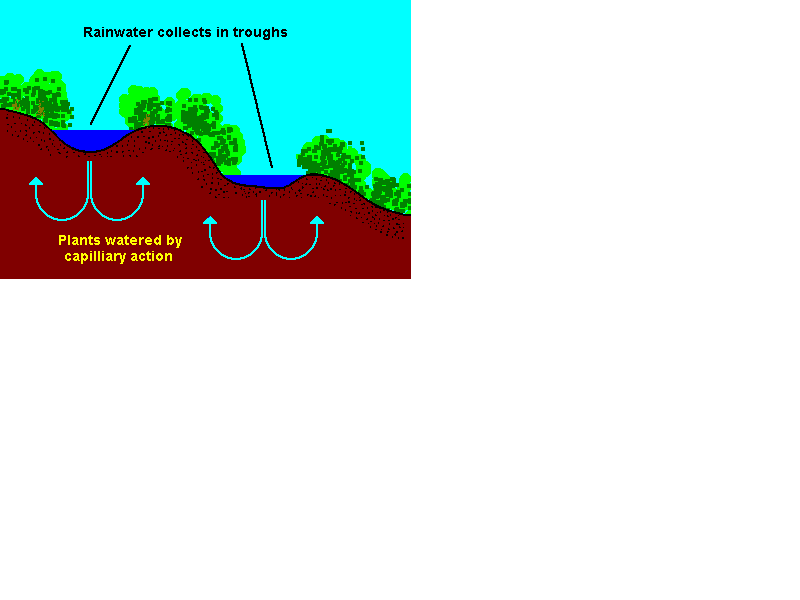|
[Front Page] [Features] [Departments] [SGAP Home Page] [Subscribe]

Getting Started 2: The Soil
Based on a series of short article aimed at the new grower of Australian native plants. The original series was written by the late Arthur Cooper and appeared in the newsletter "Native Plants for New South Wales" in the early 1970s. It was subsequently updated and reprinted in the same newsletter in 1990-91.
Different sorts of plants need different soil conditions; there is no single set of conditions which suit all Australian native plants. Get advice on what sorts of plants do well in your soil, and concentrate on those. An ordinary gardener wouldn't expect success with rhododendrons in limestone country, or with rhubarb in deep sand. Similarly with Australian native plants.
One general rule can be given; the soil should be well drained. It's best if the drainage is vertical with the water soaking deep into the sub-soil. In the many cases where this is impossible, terracing is a help. But good drainage isn't just needed for Australian native plants; it's something which helps almost any garden.
Your soil will probably repay some improvement. Very light sandy soils need organic matter and there are few species which won't do better with an addition of up to 10% of rotted or rottable organic matter to the 'bush-sand' type of soil. If you have a well-established and healthy garden of conventional plants, most Australian natives will do well in it. Some (boronias, for example) will find it too rich. If you have such a garden but in a run-down unhealthy state, once again, add organic matter.
If your soil is clayey, don't panic. Many species do well in clay and some need clay (in fact, 5 or 10% of clay dug into light, sandy soil is a great help). Good drainage is always advised for clay soil, but it is rarely practicable, because clay soils are often too level for the water to have anywhere to drain to. But do what you can to avoid stagnation. Don't dig big holes for your plants, which you fill with lighter soil (perhaps with some stones in the mistaken idea that they improve drainage) because these holes will act as sumps in which water will collect and will never drain away, so your plants will rot.
Additives can help clay. Adding sand is useless, merely making the clay harder to handle without making it any better for plants. Dumping sandy soil on top of the clay is worse; you immediately get the disadvantages of sand followed, after a few months, by those of clay. Any additives must be mixed in with the clayey soil as completely as your resources and your patience will allow. Suitable additives for mixing in are texture improvers such as gypsum (a fairly inert additive) or most organic matter.
 
Improvement in drainage can be obtained by the 'cut and fill' method on sites which have some natural slope. This involves digging areas for paths and mounding the removed soil into 'hills' about 30 to 50 cm high for planting. Pathways should be designed to remove surface water. Importing some soil may also help but some care is needed. Thoroughly mix the imported and local soils so that rapid changes in texture are avoided. Imported soils may also result in the importation of weed seeds.
 
An established garden should be self-sufficient in organic matter and should be producing plenty of compost. But you can substitute, or add, other mixtures, such as peat-moss or well rotted sawdust, together with animal manures. Peat-moss is becoming very expensive and its use is not recommended by environmental groups due to the adverse impact its mining has on natural areas. Rotted sawdust (preferably hardwood - avoid softwood if it has been chemically treated) is becoming more popular. Mix the sawdust with 5 to 10% of manure, dampen it and leave it for several weeks to break down. When you are preparing a new bed, dig the organic matter in as thoroughly as you can.
Your preparation is best done before planting anything. Tilling around the plants will damage the roots, which is especially harmful to many native plants. Similarly, make sure that the soil has been able to stabilise itself before you plant, so that it will afford a support for the plant roots. Root movement is a frequent cause of plant death.
Instead of hoeing, use a mulch to conserve moisture in the soil and to deter weed-growth, but keep the mulch away from the stems of your plants so as to reduce the risk of fungus growth which may lead to rotting of the stems. And avoid mulches (such as a thick layer of eucalyptus leaves) which will act as a 'thatch' and keep rain from soaking into the soil. The mulch will serve as a means of getting plant foods into the soil. Anything lightly sprinkled on top of the mulch will be slowly passed down into the soil. The growth of most species will be improved by giving a little of a general garden fertiliser in the springtime scattered over the top of the mulch, to be watered in artificially or by rain - about a quarter of the quantity recommended for general garden plants. Fertilizer will, incidentally, help to feed the organisms in the mulch and speed up its decomposition and the release of further organic food into the soil.
Finally it's important to remember, especially at the 'getting started' stage, that it's best to concentrate on species which do well in your sort of soil. And it must also be emphasised that soil types can be very local things which can differ markedly between locations only a short distance apart.

[Front Page] [Features] [Departments] [SGAP Home Page] [Subscribe]
Australian Plants online - September 1998
The Society for Growing Australian Plants
|